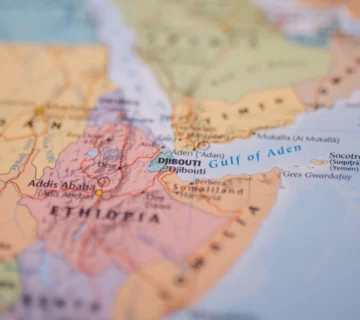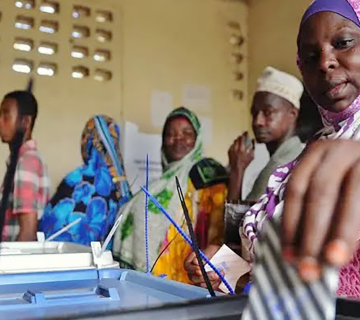Rapid climate change, which has both traditional security and human security implications for Kenya, is a contemporary issue that requires securitization. Despite efforts to help vulnerable groups cope with negative effects of climate change, the gap between food consumption and production continues to grow, leading to conflicts over resources that are becoming increasingly scarce. The Kenyan government should prioritize climate change as a national security issue by combining initiatives involving, reforestation, green and renewable energy, migration, defence, and security sectors.
Kenya’s Vulnerability and Capacity to Adapt to Climate Change
Historically, the main driver of inter-communal conflict in Kenya, has been access and control of natural resources such as water, pasture, and land. Kenya’s socio-economic systems are vulnerable to climate change. There has been a trend of less reliable rainfall and increasing temperatures increasing episodes of floods and drought in Kenya. Reports by pastoralists and farmers whose farming practices are reliant on rainfall indicated that there is an ever-changing and contrasting drought cycle. According to the World Resources Institute, water, which is an already scarce resource, is the primary affected resource nationwide by these changes. This exposure and sensitivity are heightened by the Kenyan economy’s dependency on rain for electricity generation and rain reliable agriculture. The World Bank estimates that agriculture contributes 26 per cent to the national GDP. The agricultural sector employs more than 40 per cent of the total population and more than 70 per cent of the population residing in the rural parts of Kenya.
In 2007, the Intergovernmental Panel on Climate Change broke down the indicators of adaptive capacity into the following: education, health, and economy/income. Kenya’s economy is facing a number of challenges, for instance, as of the first quarter of 2021, 16.3 per cent of the population between the age of 20 to 24 years is unemployed. In addition to this wealth in the country is unevenly distributed and as of the year 2021, 16 per cent of the population is living below USD 1.90 per day. Research has shown that formal education in pastoralists communities can help mitigate the risk of droughts. According to the United Nations Development Programme, Kenya’s education is above average in sub-Saharan Africa in the inequality-adjusted education index (which is a combination of the gross enrolment ratio and adult literacy rates). Unfortunately, while primary education is free, government schools receive insufficient funds and resources from the government thus limiting the quality of education and its reach.
Health is the final indicator, which also shows a disparity between the populations in urban and rural areas in Kenya. An approximated 15 million people in Kenya are relying on unimproved water sources like rivers, shallow wells, and ponds. While 41 per cent of the population does not have access to basic sanitation solutions. On average, the cost of getting a reliable water supply in rural areas is USD 38 per month and USD 4.46 per month in urban areas, especially Nairobi.
Risks Faced by Communities Adversely Affected by Climate Change
The direct implications of climate change include increased droughts, rising temperatures, higher unpredictability of rainfall, more heavy rain and floods, and rising sea levels. These impacts on the environment are directly linked to the following risks: reduced crop yields and change in crop cycles, change in the spread of diseases, and stress on water resources among others. In Kenya, these risks to the community make the affected regions susceptible to violent conflict because of an over-dependence on rain reliant economic activities, the ever-growing population increasing demand for already scarce-arable land, and limited state capacity to adapt and cope with climate change effects.
Irrigation Projects such as Galana Kalalu Scheme have been set up by the government in conjunction with the private sector to address the risks above. Unfortunately, the Galana Kalalu project which was contracted to Green Arava Limited and under the charge of the National Irrigation Board underperformed. Funding was subsequently cut, and in 2018/2019, no amount was earmarked for the project, followed by a 10 million allocation in 2019/2020. River Sabaki-Galana dried up as a result of the project, making life difficult for the surrounding community which relied on the river for a livelihood.
Securitizing Climate Change
The securitization of climate change cannot be undertaken lightly, if the government overplays their hand there is a danger of creating panic among the general population, or climate change fatigue. The recommended implementation plan is discourses and practices that combine climate change with migration, development, security, and defence. This would be in two ways: Firstly, engaging in civil-military stability interventions that are aimed at developing state infrastructures. Various projects can be developed this way such as expanding forest conversation and its protection, developing of locally owned and managed irrigation projects, and engaging in mass education drives on climate change. The development of sustainable and green energy plants is key to ensuring that Kenya’s socio-economic systems are resilient to climate change shocks. This level of engagement ensures that long-term solutions are being implemented and sustained by key stakeholders.
Secondly, implementing military-responsibility-to-protect interventions that are aimed at protecting vulnerable citizens. For instance, the populations that are forced to migrate due to climate change. While efforts are being made in the state to reduce Kenya’s vulnerability to rapid changes in climate, it is crucial to address the immediate insecurities that are facing society. These military interventions can be used to ensure that even as traditional migration routes among pastoralists and wildlife change, the peace is kept, this can be done by ensuring that dangerous animals in search of food are not wandering into human encampments. Additionally, they can set up agreements between communities that are going to be affected by these changed routes. Food and nutrition security can be addressed across the country by deploying aid through the military, which have the capacity to reach remote groups.
Raudhat Sayeeda Saddam is a Researcher at the HORN Institute
Photo: A woman fetches water in unidentified location in South Sudan (Photo Credit: WFP/Gabriela Vivacqua)
The contents of this article are copyright of © The HORN Institute 2022. All rights reserved. Any redistribution or reproduction of part or all of the contents in any form and for whatever reason is prohibited. You may use the content of this article for personal reasons, but acknowledge the website as the source of the material.



